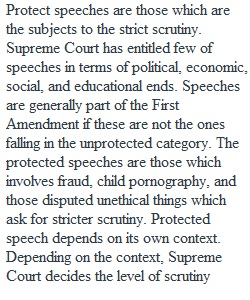


Q After you have read Chapter 2: Ethics Matters- Understanding the Ethics of Public Speaking, and taken Quiz 3, you will need to complete the next Discussion/Response Assignment. We'll be exploring aspects of the First Amendment to the Constitution— which is the basis of this course and one of the reasons why you and college students throughout the United States have enrolled in a public speaking class. First, make sure you have read Section 2.3 Free Speech of our e-text, then carefully study the materials in these web resources— https://www.law.cornell.edu/wex/first_amendment (Links to an external site.) https://www.law.cornell.edu/wex/fighting_words (Links to an external site.) Next, watch the following video: The Freedom of Hate Speech; a Call for Civil Dialogue-- TEDx Talks. (2019, October 14). The Freedom of Hate Speech; a Call for Civil Dialogue | Katia Campbell | TEDxMSUDenver [Video]. YouTube.https://www.youtube.com/watch?v=xD6_Ma5vutw (Links to an external site.) Afterwards, develop a paragraph of at least 10-12 sentences based on one of the following prompts. Choose one of these and reflect on what you learned in your e-text and the video: • What is (and is not) considered “protected” speech in the United States. Clarify. • Why is there a distinction between speech that is “protected” and “unprotected”? (Where do "fighting words" and “hate speech” fit into these classifications?) • How might the concept of "civil dialogue" impact the messages you send and receive in your face-to-face and digital communication? Remember you are to blend your personal perspective and appropriate life experience. You do want to refer to the reading and video, but write in your own voice. Finally, review as many of your classmates' comments as possible and respond to at least 3. Remember, you're not just posting a sentence or two. Do your best to develop your writing so that you're moving the conversation forward. Those are the types of responses we're looking for throughout this communications class. Always plan to go a step further. Engage your classmates in a conversation about what they are concerned with or interested in. Talk to each other like you are in the same classroom-- because you are! Refer to the Discussion/Response Assignments portion of the syllabus for examples of postings that demonstrate higher-level thinking. (You'll also want to review the Discussion/Response Rubric in the syllabus to see how your work will be evaluated.)
View Related Questions